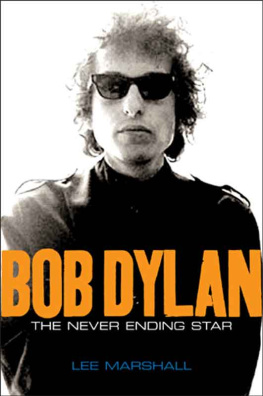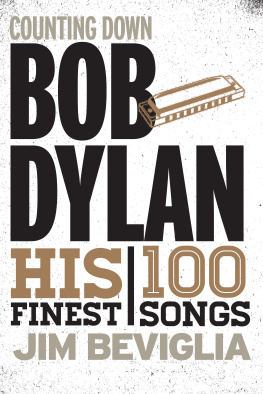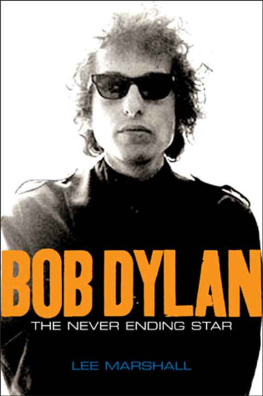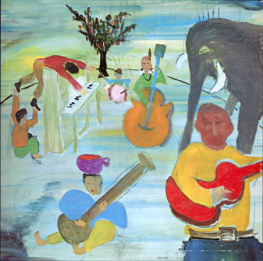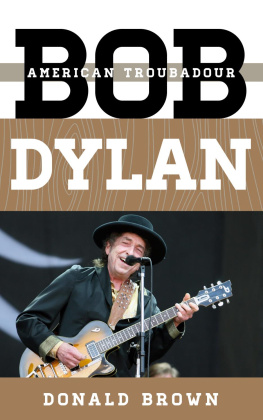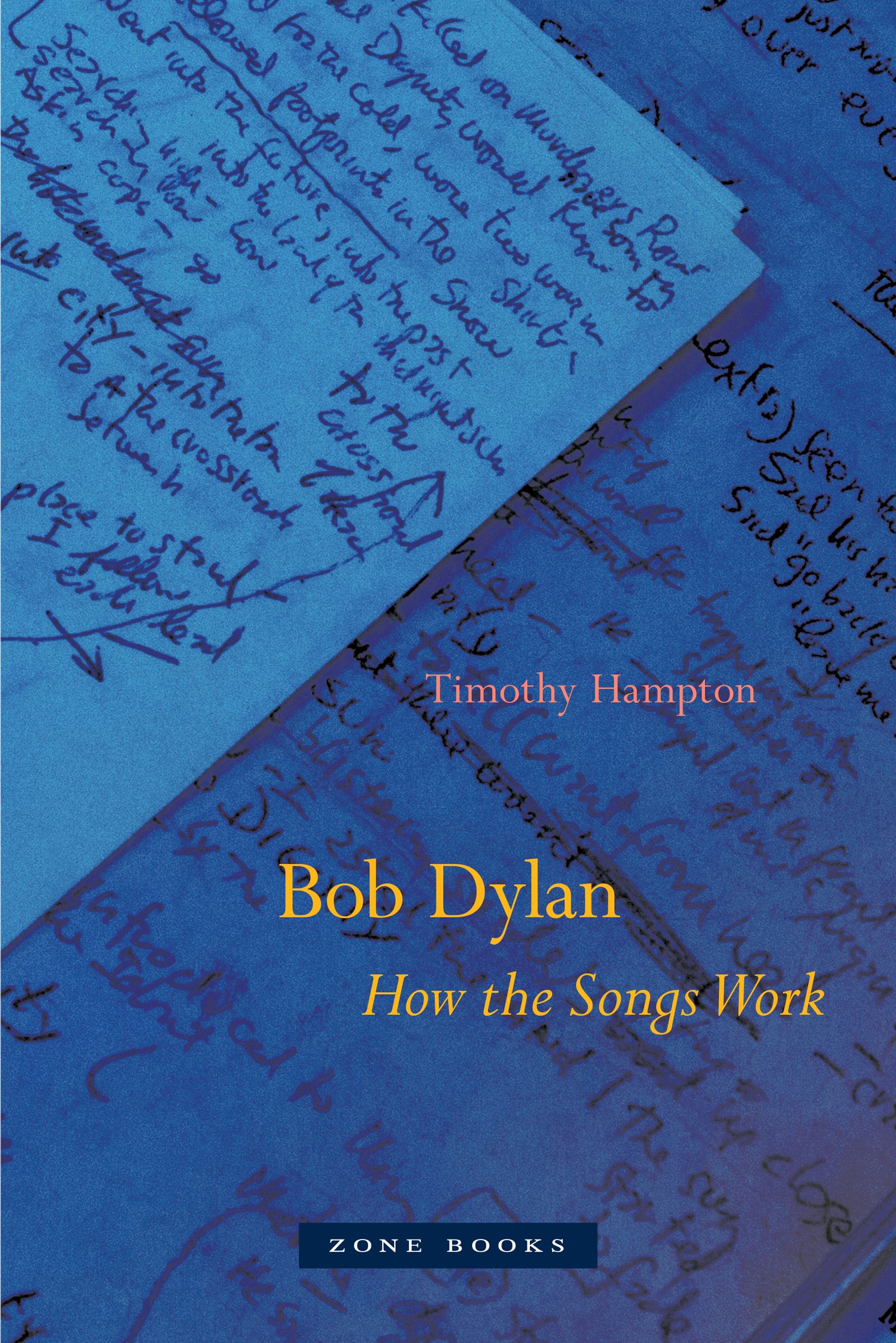All rights reserved.
No part of this book may be reproduced, stored in a retrieval system, or transmitted in any form or by any means, including electronic, mechanical, photocopying, microfilming, recording, or otherwise (except for that copying permitted by Sections 107 and 108 of the U.S. Copyright Law and except by reviewers for the public press), without written permission from the Publisher.
Distributed by Princeton University Press, Princeton, New Jersey, and Woodstock, United Kingdom
Names: Hampton, Timothy, author.
Title: Bob Dylan : how the songs work / Timothy Hampton.
Description: New York : Zone Books, 2019. | Includes bibliographical references and index.
Subjects: LCSH: Dylan, Bob, 1941Criticism and interpretation. | Popular musicUnited StatesHistory and criticism.
INTRODUCTION
A Maker
A drumbeat from your finger releases all sound,
and a new harmony begins.
Arthur Rimbaud, To a Reason
This is a book about songs and how they are made. It is about the intersection of lyric, music, and performance. It studies how the forging of these elements produces art that is more than the sum of its parts. My topic of study is the songs of Bob Dylan, the most influential popular songwriter of the last half century. Although Dylans acceptance of the 2016 Nobel Prize in Literature has elevated his status, pushing himcontroversially, of courseout of the world of popular music and into some larger sphere of creative achievement, much of the critical writing about Dylan has tended to skirt or neglect the artistic nuances that give life to the work of this most dynamic and skillful writer and composer. This book offers a close investigation of how the songs work as compositions, as structures, as systems of signs that create meaning and elicit emotion. Neither a technical musicological study nor an exercise in traditional literary criticism, it seeks out places where language and music shape and support each other. It studies in detail Dylans writing technique, his intertwining of lyric and music, and his engagements with broader cultural and political topics. It is intended as an investigation of the work of a major artist, an exercise in the close analysis of song, and, on a more practical level, a set of guideposts to Dylans compositions.
The massive body of writing about Dylans career and the size and variety of his recorded output have generated an entire collection of different Dylans and of different ways of framing his work. Three approaches come to mind as particularly influential and insightful. The first is what we might call Dylan as disruptor. Dylan is an entertainer, a song and dance man, as he once described himself. His initial success was linked to the way he introduced serious and complex lyrics into the mainstream of popular musica development that transformed the field. Because many of his songs touch on political or moral concerns, he was quickly labeled a philosopher or spokesman, an existentialist prophet, the voice of a generation, able to offer up gnomic pronouncements at will.
As Dylans stature has grown, it has become clear that certain themes are consistent across his work. From his earliest days he has not shied away from passing judgment or casting light on racism, greed, corruption, and the miscarriage of justice. This tendency has taken on new importance with the Nobel Prize in Literature, which has often gone to artists known for their moral visions or political stances (Boris Pasternak, Pablo Neruda, Nelly Sachs, and Toni Morrison, among others). Indeed, some of the best work on Dylan of the past two decades sees him as a kind of moral philosopher, setting him in dialogue with other writers, from Virgil to Eliot, yielding insights into the ethics, as well as the mechanics, of his writing. This work has drawn its strength and wisdom from a close consideration of Dylans lyrics, to the relative exclusion of his music. And if the narrative of Dylan as disruptor often casts his artistic trajectory as a story of decline, here we run the risk of a version of Dylan that fails to account fully for the changes in his work, setting him up as always doing more or less the same thing. My book will track how his approach changes, how his moral concerns can both remain constant, yet be articulatedboth lyrically and musicallyin vastly different ways across time.
Dylans deep sense of history and his curiosity about different musical traditionsfrom Mexican border ballads to western swinghave led some commentators to see his work as a kind of parable about American identity and inclusiveness. Here he is taken less as an existentialist hero or a great ethicist than as a quintessentially American bard, the heir to Walt Whitman and William Carlos Williams, speaking of and to the promise of America. This is a critical approach that has occasionally considered both music and lyrics and has opened important perspectives on the work, not least by showing how Dylan moves between what used to be called high culture and popular culture. That I put scare quotes around those two terms is itself testimony to the success with which Dylan, along with a few of his contemporaries, has succeeded in blurring once distinct categories. Yet, a strict focus on Dylans Americanness (more scare quotes) runs the risk of limiting our sense of the songs aesthetic impact and formal complexity. Much of the power of Dylans art emanates from how he breaks conventions, or merely gestures toward them as he passes by. For example, he does not sing the blues: he uses the blues.
My own discussion will focus on how Dylan gets his job done. I want to look at features of the work that can help us grasp questions of politics, history, and ethics beyond the level of theme or argument. My interest will be in style and formfeatures that should ground any broader consideration of the authors cultural importance. For it is in the intersection of lyric and musicin the details of structurethat Dylans art generates new types of knowledge. Lyric poetry, like much song, often seems to live outside of history and the flow of social conversations. Yet, precisely for this reason, we can turn to lyric forms for insights into social experience. As the poet Robert Pinsky has noted, in lyric, Communal life, whether explicitly included or not, is present implicitly in the cadences and syntax of language: a somatic ghost. Put differently, songs are most political when they are not talking about politics, but when they are giving voice to the social relations and the play of power and resistance that shape our collective experience. For it is then that songlike any artcan generate new types of knowledge, grasping what cannot yet be conceptualized in thought.
Yet, one might wonder, why focus on one author who will be singled out for attention? Does this not in some sense privilege an idea of the songwriter as genius (as outmoded as that idea may be today)and a white male genius at that? Would it not be better to set Dylan up as one of a pack, in the history of a mode of representation (in this case, rock and roll), or in the history of a moment (American popular cultures rise to global dominance)? The answers to this are several. First, as will be clear, Dylans work is obsessively about dialogue and about the multiple voices through which art takes shape. In this regard, we might understand Bob Dylan less as some type of discrete genius than as a site, a wavering node of influences that coalesce to speak in new ways, through which we can reflect on the kinds of knowledge that art makes happen. But more compelling, perhaps, is that Dylans own art, from its very first manifestations, has consistently questioned, taken apart, and criticized every feature of the very culture that has made it possible, from the arrogance of stardom to the vacuity of the press and the capitalist machine underpinning middle-class consumerism. And he has developed modes and tools for understanding and grasping collective experience, our relationship to language, memory, and formour somatic ghosts. This is why even when Dylans art is irritating or confrontational, it elicits attention from listeners. For it is clear that something is happening in it that speaks to both our moment and beyond our moment, something that points to the space where ideas end and where, as Pinsky puts it, the body recognizes the stirring of meaning. To do this, as we will see, Dylans art steadfastly refuses to limit itself, to offer convenient positions on topics of importance. These are the positions (on race, identity, sexuality, state power, commercialism, and so on) that are often set forth in the art of Dylans colleagues. They are, in themselves, useful. What sets Dylan apart is that his work registers the impact of social and political change, not only on selves and communities but also on art itself, as the medium of communication.


